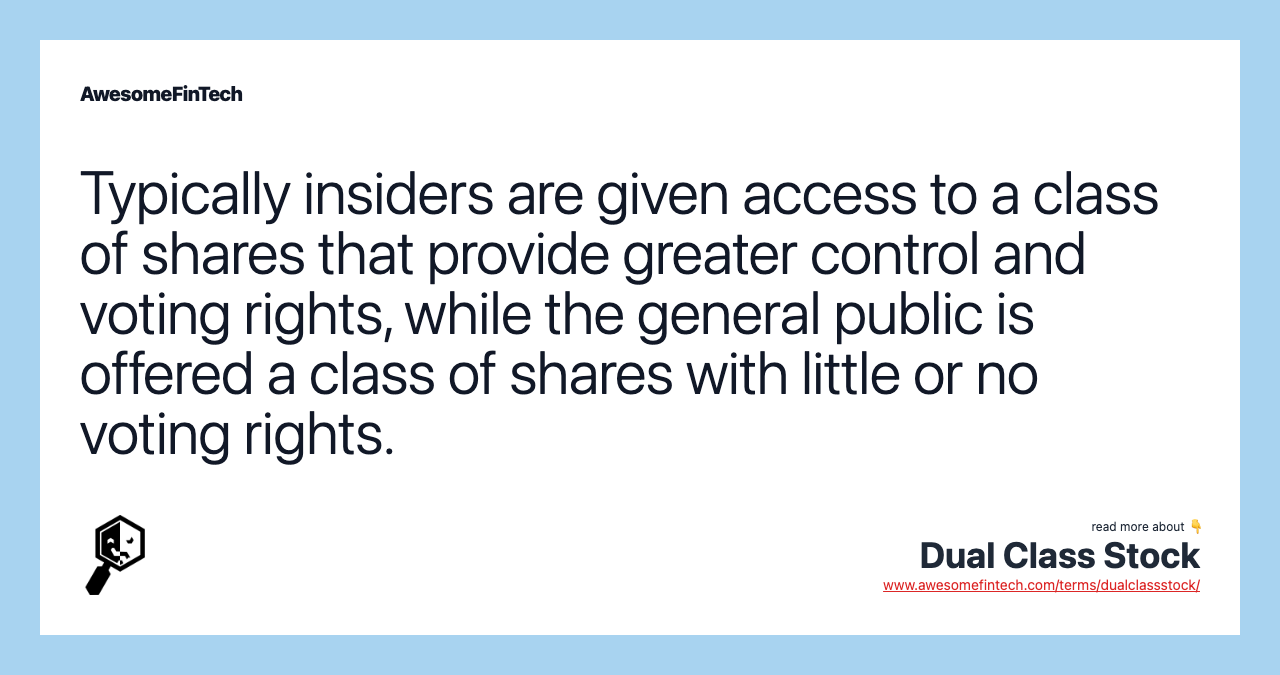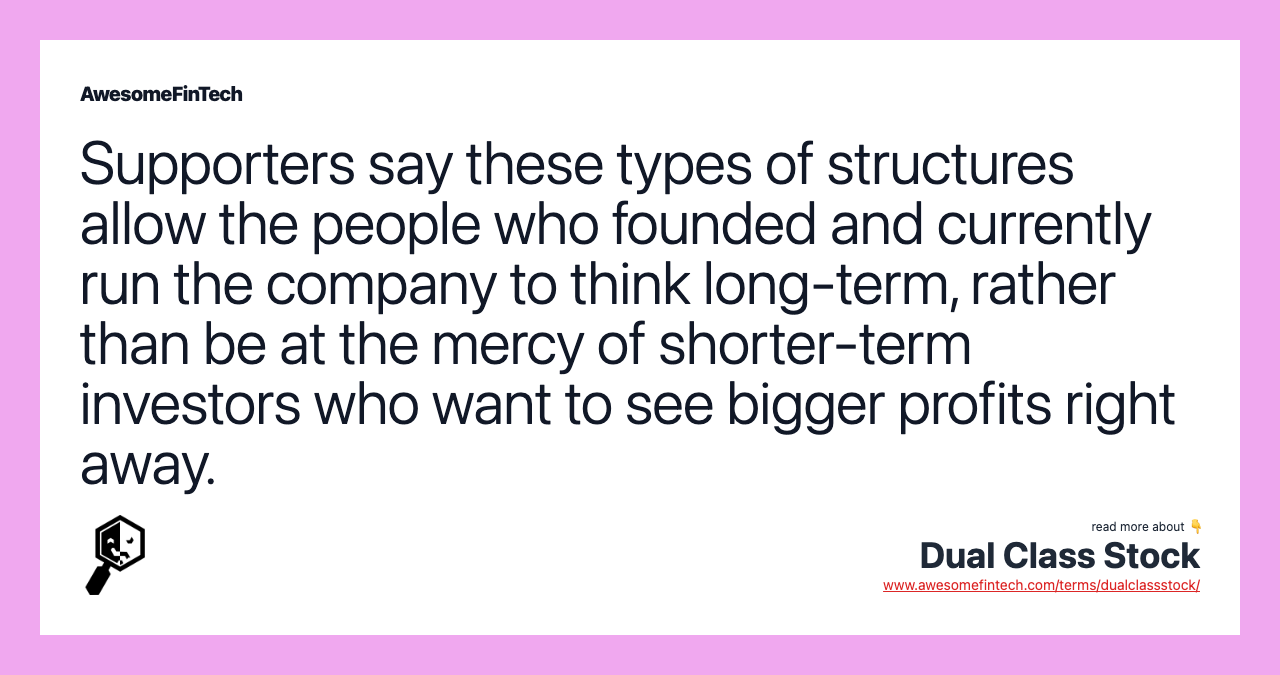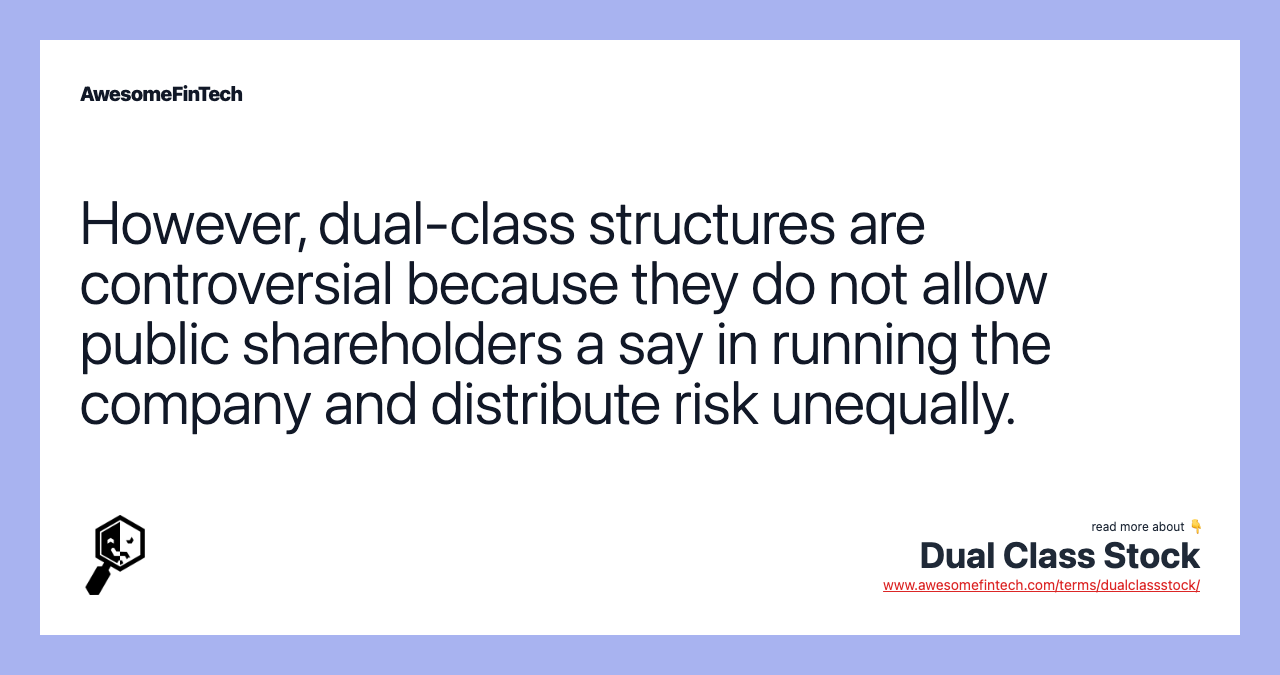Dual Class Stock
A dual class stock is when a company issues two share classes. Typically insiders are given access to a class of shares that provide greater control and voting rights, while the general public is offered a class of shares with little or no voting rights. The class offered to the general public often has limited or no voting rights, while the class available to founders and executives has more voting power and often provides for majority control of the company. Once shares are listed, companies cannot reverse any voting rights attributed to the new class, or issue any classes of shares with superior voting rights. The New York Stock Exchange (NYSE) banned dual-class structures in 1926 after an outcry over automotive company Dodge Brothers' public offering, which consisted of non-voting shares for the public.

What Is a Dual Class Stock?
A dual class stock is when a company issues two share classes. A dual class stock structure can consist of Class A and Class B shares, for example. These shares can differ in terms of voting rights and dividend payments.
When multiple share classes of stock are issued, typically one class is offered to the general public, while the other is offered to company founders, executives, and family. The class offered to the general public often has limited or no voting rights, while the class available to founders and executives has more voting power and often provides for majority control of the company.




Understanding a Dual Class Stock
Dual class stock is designed to give specific shareholders voting control. Classes of stock with unequal voting shares may be created to satisfy owners who don't want to give up control, but do want the public equity market to provide financing.
In most cases, these so-called super-voting shares are not publicly traded and company founders and their families are most commonly the controlling groups in dual-class companies. Although there is no standard nomenclature for multiple share classes, Class A shares are normally superior to Class B shares. In other cases, though, the reverse is true. That's why investors should research the details of a company's share classes if they are considering investing in a firm with more than one class of shares.
Well-known companies, such as Ford and Warren Buffett's Berkshire Hathaway, have dual class stock structures, which provide founders, executives, and families the ability to control majority voting power with a relatively small percentage of total equity.
The dual-class structure at Ford, for instance, gives the Ford family control of 40% of the voting power, while owning a small percentage of the company's total equity. An extreme example is Echostar Communications CEO Charlie Ergen, who holds 5% of the company's stock, yet controls around 90% of the vote with his powerful Class A shares.
Dual-class structures allow companies to access public capital without sacrificing control.
Special Considerations
While they've recently become popular, dual-class structures have been around for some time in various forms.
The New York Stock Exchange (NYSE) banned dual-class structures in 1926 after an outcry over automotive company Dodge Brothers' public offering, which consisted of non-voting shares for the public. However, the exchange reinstated the practice during the 1980s in the wake of competition from other exchanges. Once shares are listed, companies cannot reverse any voting rights attributed to the new class, or issue any classes of shares with superior voting rights.
The approximate percentage of U.S. companies in the Russell 3000 Index with a dual- or multiple-class structure, according to a Harvard Law School study.
In recent times, the number of companies opting for a dual-class structure during listing has multiplied. This is particularly the case among technology startups, many of which use this strategy to retain control over their outfits.
Alphabet Inc.'s Google is the most famous example of this trend. Many were frustrated at Google’s initial public offering (IPO) when the now-internet giant, boasting a market capitalization among the top thirty worldwide, issued second Class B shares to founders with 10 times the amount of votes as the ordinary Class A shares sold to the public.
Several stock indexes have stopped including companies with dual-class structures. The S&P 500 and FTSE Russell are examples of this trend.
Dual Class Stock Controversy
Dual class stock structures are controversial. Their supporters argue that the structure enables founders to demonstrate strong leadership and the placing of long-term interests over near-term financial results. It also helps founders retain control over the company as potential takeovers can be avoided through their supermajority voting shares.
On the other hand, opponents argue that the structure allows a small group of privileged shareholders to maintain control, while other shareholders (with less voting power) provide the majority of the capital. In effect, there is an unequal distribution of risk.
The founder is able to access capital from public markets at minimal economic risk. Shareholders carry a major part of the risk related to strategy.
Academic research has proved that powerful classes of shares for insiders can actually hinder long-term outperformance. A middle path has been suggested by another group of shareholders. According to them, the effects of a dual-class structure can be limited by placing a time-bound restriction on such structures and allowing shareholders to accumulate voting interest over time.
Examples of Dual-Class Structures
As mentioned earlier, Alphabet subsidiary Google is the most famous example of a company with a dual-class structure. When it listed in 2004, the search giant unveiled two classes of shares in its offering. Class A shares were reserved for regular investors and had one vote per share. Class B shares were reserved for founders and executives and had 10 times as many votes as those for other classes.
Later, the company added a third class of shares. These Class C shares came with zero voting rights.
Other examples of companies with dual-class structures are Facebook, Zynga, Groupon, and Alibaba.
Related terms:
Alphabet Stock
An alphabet stock is an equity share that is tied to a specific subsidiary of a corporation. read more
Berkshire Hathaway
Berkshire Hathaway is a holding company for a multitude of businesses, run by chair and CEO Warren Buffett. read more
Class A Shares
Class A shares refer to a classification of common stock that was traditionally accompanied by more voting rights than Class B shares. read more
Class B Shares
Class B shares are a share class of common stock of a corporation, but often with fewer or limited voting rights compared to Class A shares. read more
Classified Shares
Classified shares are different classes of common stock, each with different voting rights, ownership rights and dividend rates. read more
Control Stock
Control stock is equity stock owned by major shareholders or those holding an influential portion of the shares of a publicly-traded corporation. read more
Dividend
A dividend is the distribution of some of a company's earnings to a class of its shareholders, as determined by the company's board of directors. read more
Equity : Formula, Calculation, & Examples
Equity typically refers to shareholders' equity, which represents the residual value to shareholders after debts and liabilities have been settled. read more
Equity Market
An equity market is a market in which shares are issued and traded, either through exchanges or over-the-counter markets. read more